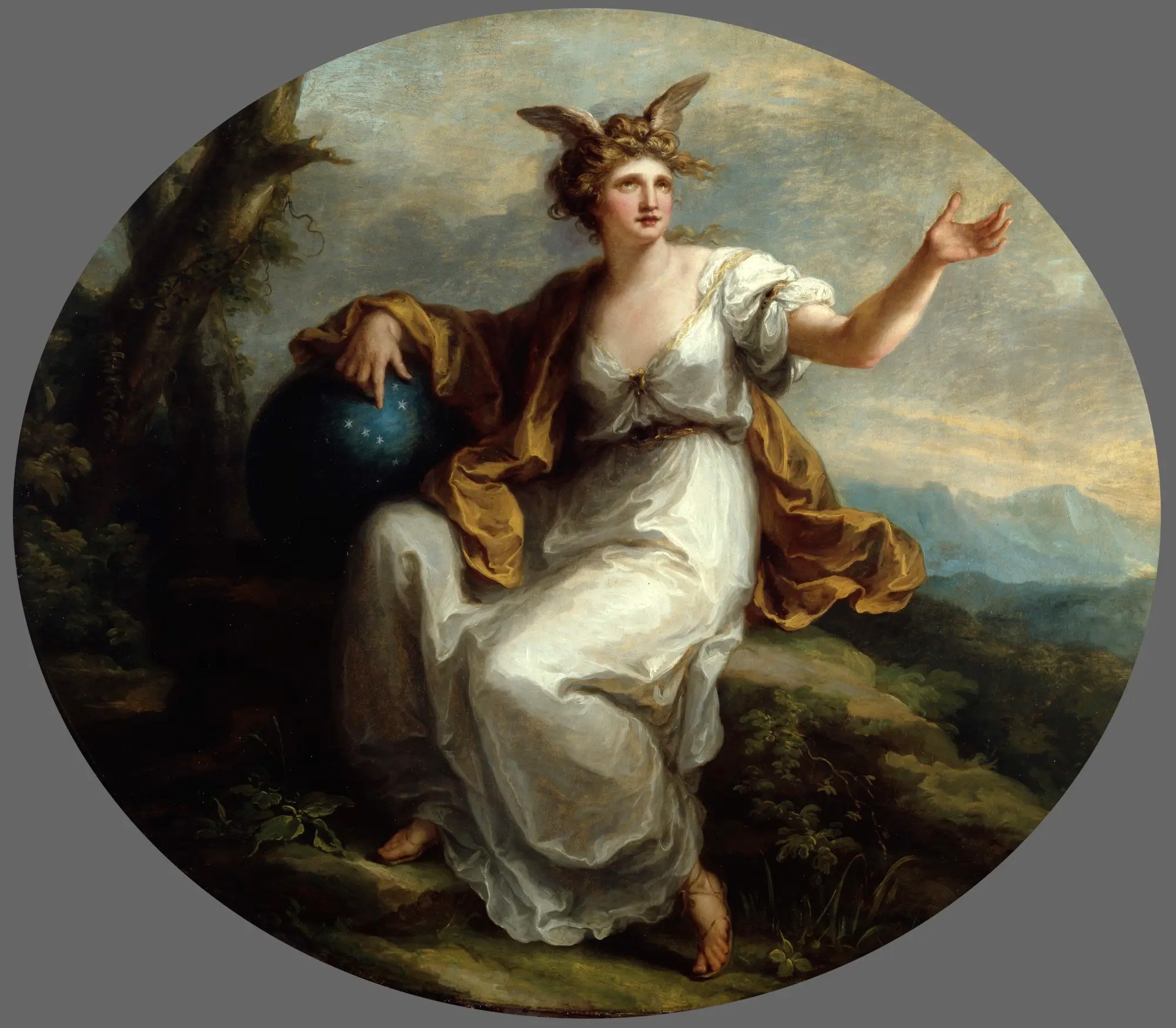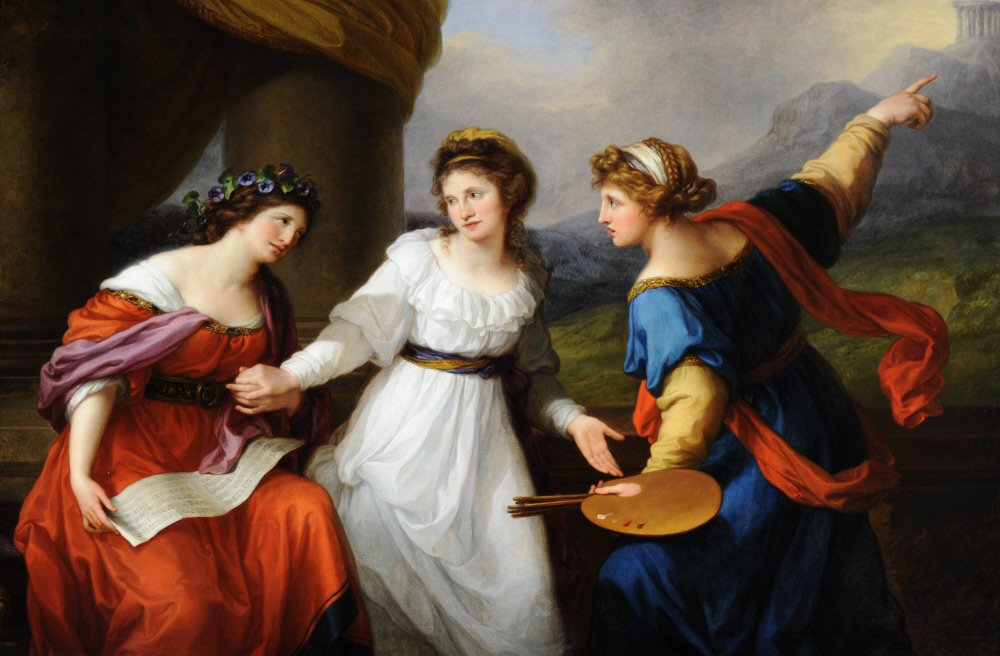Angelica Kauffman II
Angelica Kauffman (1741-1807) was a highly celebrated artist during her lifetime, enjoying a reputation as a talented painter and respected business woman. This article, the second in a two-part series on Kauffman, will examine some of her key works in close detail, exploring how she used colour in harmony with other painterly elements to create her famous celebrity portraits and pioneering history paintings. To learn more about Kauffman’s life and achievements, you can find part one of this series here.
Angelica Kauffman: Colouring, oil on canvas, 1778-80
Image Credit: Royal Academy
Kauffman was commissioned by the Royal Academy to create four paintings to decorate the ceiling of the new Council Room at Somerset House, which opened in 1780. These four paintings, titled Colouring, Design, Composition and Invention are collectively known as ‘Elements of Art’. They’re thought to relate to Joshua Reynolds’ theory of art which he set out in his 1778 Discourses on Art. Reynolds was a close friend of Kauffman’s and a fellow founding member of the Royal Academy.
Kauffman represents all four elements as allegorical, muse-like female figures. Colour and design are painterly elements which are often directly opposed to one another in artistic theory - people have often debated whether it is the expressive passion of colour or the structured order of design which makes a painting good. Here, Kauffman harmonises these elements, but there is a clear distinction in her interpretation of the two.
Colour, dressed in loose robes and with flowing hair, reaches gesturally towards the sky with her paintbrush. She is taking pigments from the rainbow above her head, to fill her currently empty palette. At her feet is a chameleon, a symbol of colour and the potential of colour to change how we perceive things. She sits within a wild, natural environment, surrounded by mountains and flora, suggesting freedom.
Angelica Kauffman: Design, oil on canvas, 1778-80
Image Credit: Royal Academy
On the other hand, Design is a more studious and focussed figure. She faces away from the viewer to concentrate on the form she is drawing - a copy of the Belvedere Torso, one of the most famous pieces of classical sculpture during Kauffman’s time. A plaster copy of this piece was on display in the same room as these paintings. Design’s focus on the sculpture references how artists were taught design by studying from classical references. In contrast to Colour, Design sits within an architectural environment inspired by classical columns, suggesting control and order.
Angelica Kauffman: Composition, oil on canvas, 1778-80
Image Credit: Royal Academy
In Colouring and Design, the allegorical figures are actively pursuing a physical artform. Comparatively, Invention and Composition are more focussed on the intellectual concerns of painting. Composition has her head turned down in thought, and is surrounded by symbols like a chess board, a compass and discarded notes, reflecting her strategic and precise approach. She sits within a landscape which incorporates both natural and architectural elements, symbolising the importance of their harmony to effective, successful composition.
Angelica Kauffman: Invention, oil on canvas, 1778-80
Image Credit: Royal Academy
Of invention, Reynolds wrote in his Discourses: ‘whenever a story is related, every man forms a picture in his mind of the action and expression of the persons employed. The power of representing this mental picture on canvas is what we call invention in a Painter’. This notion can be seen in Kauffman’s painting - Invention is deep in thought, holding a celestial globe, with her eyes and hand turned towards the sky. This pose suggests the ability to form and express higher thoughts and to relay them through painting. This is particularly relevant to Kauffman’s passion for history painting - she was skilled at taking historical, classical and biblical narratives, and translating them into a visual snapshot of a story which could be interpreted and understood by audiences. In subsequent works, it is evident how Kauffman used all these elements in harmony to create her paintings.
Angelica Kauffman: Cornelia Pointing to her Children as her Treasures, oil on canvas, about 1785
Image Credit: Virginia Museum of Fine Arts
Cornelia Pointing to her Children as her Treasures is perhaps Kauffman’s most well-known history painting, and is a great example of her skill in presenting history painting narratives, and her propensity for doing so from a female perspective. In Ancient Roman legend, Cornelia was the mother of Tiberius and Gaius, two brothers who brought about great social reform in the Roman Republic, eventually dying for their beliefs. They are the two children in the left of the composition. Rather than focussing on the brothers directly, Kauffman celebrates Cornelia as ‘the good mother’. In contrast to the other woman in the scene, who is coveting jewellery, Cornelia hails her children as her true ‘treasures’. Kauffman uses a limited, neoclassical composition and muted colour palette to tell this story. However, her diffused style is softer than typical neoclassical works, and is indicative of the Rococo influence of her training and work in her early career.
Kauffman painted this work on her return to Italy, and was subsequently commissioned to paint two further versions for other patrons.
Angelica Kauffman: Portrait of Emma, Lady Hamilton, as Muse of Comedy, oil on canvas, 1791
Image Credit: RA, Private collection
As well as history paintings, Kauffman was also an in-demand portrait artist and was commissioned to paint several celebrities of her day. This included Emma, Lady Hamilton, an eighteenth-century socialite, model, dancer and actress. Lady Hamilton was predominantly famous for her relationships to famous men, including as the wife of William Hamilton, the muse of artist George Romney and, perhaps most notably, the lover of Lord Nelson.
Kauffman chooses not to communicate any of this in her portrait of Lady Hamilton however, again demonstrating her desire to give women their own narratives and focus on female-centric stories. Lady Hamilton was well-known for her ‘attitudes’ - quick-change recreations of classical figures and poses, for entertainment. Here, Kauffman shows her as Thalia, the Greek muse of comedy. She holds a laughing mask and is dressed in classical-style robes, and is poised as if emerging from behind a curtain to address an audience. The colours Kauffman employs are earthy and muted, imbuing this portrait with dignity and naturality, whilst Lady Hamilton’s face and arm glow out from the green background, highlighting her skill in performance.
Angelica Kauffman: Self-portrait of the Artist hesitating between the Arts of Music and Painting, oil on canvas, 1794
Image Credit: National Trust
Kauffman had a long career. She lived to be 66 and painted well into her later years. Self-portrait of the Artist hesitating between the Arts of Music and Painting was painted when Kauffman was 50 years old, perhaps beginning to look back at and reflect on her career.
The work shows Kauffman situated between the allegorical figures of Music and Painting. On the left, Music is dressed in pinks and reds, holding sheet music and gazing beseechingly at Kauffman. On the right, Painting also gazes intently at Kauffman. She is wearing primary colours and is gesturing to a temple on a hill in the distance. Kauffman, in the middle, holds Music’s hand but is gesturing towards Painting.
In her early life, Kauffman was trained as a painter by her father and a musician by her mother, and exhibited great talent as both. An anecdotal story tells of a time when, struggling to decide between the two pursuits as a career path, the young Kauffman visited a priest for guidance. Allegedly, the priest told Kauffman that painting was a more noble, virtuous pursuit than music, and that this was the career she should follow.
This self-portrait certainly seems to reflect those values. Kauffman’s white dress symbolises her virtuous nature, and Painting, dressed in the primary building blocks of colour, is guiding her through a difficult but ultimately rewarding journey up the steep, rocky mountain to the temple. Music, on the other hand, has pink and red robes which could suggest seductiveness, and wears her hair in a looser style. Kauffman looks apologetically towards Music but it is clear that she has made the choice to follow Painting, reflecting the choices that Kauffman made in her real life.
Kauffman was an exceptionally prolific artist, creating hundreds of works throughout her career. In recent years, Kauffman’s reputation is recovering from the centuries she has spent obscured since her death, through academic research, art historical representation and featuring in flagship exhibitions including a long-awaited retrospective at the Royal Academy. Kauffman is today acknowledged and celebrated for her work ethic, her unique approach to the neoclassical style, and her determination to highlight and represent female narratives through her pioneering history paintings.
Sources
Art Cites. “Art 318 - Angelika Kauffmann - Part 1 of 2” uploaded by Molly Enholm, 2019 https://www.youtube.com/watch?v=UMnoBTliKXk
Art Cites. “Art 318 - Angelika Kauffmann - Part 2 of 2” uploaded by Molly Enholm, 2019 https://www.youtube.com/watch?v=9bBUazKM-Mw
Royal Academy:
Video: Bridgerton's Adjoa Andoh on 18th-century star Emma, Lady Hamilton | Royal Academy of Arts
Colouring | Works of Art | RA Collection | Royal Academy of Arts
Design | Works of Art | RA Collection | Royal Academy of Arts
Composition | Works of Art | RA Collection | Royal Academy of Arts
Invention | Works of Art | RA Collection | Royal Academy of Arts
Angelica Kauffmann | Portrait of Emma Hamilton | The Metropolitan Museum of Art
Images
Colouring | Works of Art | RA Collection | Royal Academy of Arts
Design | Works of Art | RA Collection | Royal Academy of Arts
Composition | Works of Art | RA Collection | Royal Academy of Arts.
Invention | Works of Art | RA Collection | Royal Academy of Arts
Cornelia, Mother of the Gracchi, Pointing to Her Children as Her Treasures (Primary Title) – (75.22)
Cover Image
Angelica Kauffman, RA, Portrait of Emma, Lady Hamilton, as Muse of Comedy, 1791, Private collection






